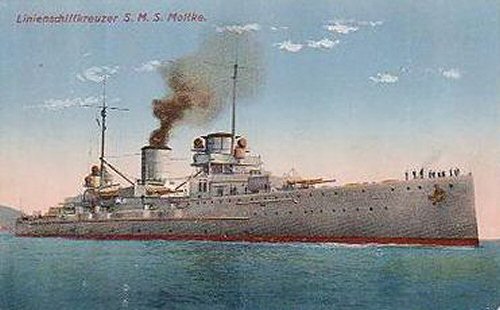
Scuttled at Scapa Flow 21 June 1919
SMS Moltke
Moltke-class battlecruiser L/B/D: 612 × 96.4 × 30.2 (186.6m × 29.4m × 9.2m). Tons: 25,400 disp Comp: 1,158 Hull: steel Arm: 10 × 11.2 (5 × 2), 12 × 6, 12 × 8.8cm; 4 × 20TT. Armor: 10.8 belt, 2 deck Mach: Parsons turbines, 85,782 shp, 3 screws; 28.4 kts Built: Blohm & Voss, Hamburg; 1911.
Commissioned in 1911, SMS Moltke was named for Franco-Prussian War hero Helmuth von Moltke; she was also a sister ship of SMS Goeben. Part of Rear Admiral Franz von Hipper's First Scouting Group, Moltke took part in the December 16, 1914, shore bombardment of Hartlepool and Whitby. She was also at the The Battle of Dogger Bank on January 24, 1915, but escaped the engagement relatively unscathed. During the German campaign to close the Gulf of Riga, Moltke was torpedoed on August 19 by the British submarine E-1. Damage was slight, and the next month Moltke was flagship of Vice Admiral Ehrhard Schmidt's task force in Operation Albion, to seize Russia's Ösel and Moon Islands.
Moltke next saw action at The Battle of Jutland on May 31, 1916. During the battlecruiser action with Vice Admiral David Beatty's Battle Cruiser Fleet, Moltke took several hits, including one 15-inch shell, but was the least damaged of the German cruisers, and Hipper transferred his flag to Moltke after the loss of Lützow. In the German Navy's last sortie of the war, April 24, 1918, Moltke was part of an unsuccessful task force sent to intercept a convoy sailing from Norway to Britain. On the return from the Norwegian coast, Moltke was torpedoed by the British submarine E-42, but she limped back to port. Interned at Scapa Flow on November 21, 1918, she was scuttled there on June 21, 1919. Raised on June 10, 1927, Moltke was broken up two years later at Rosyth.